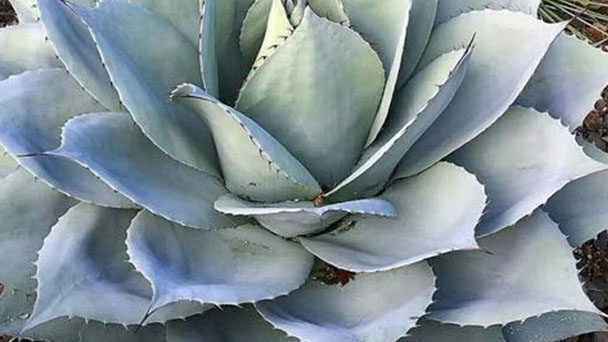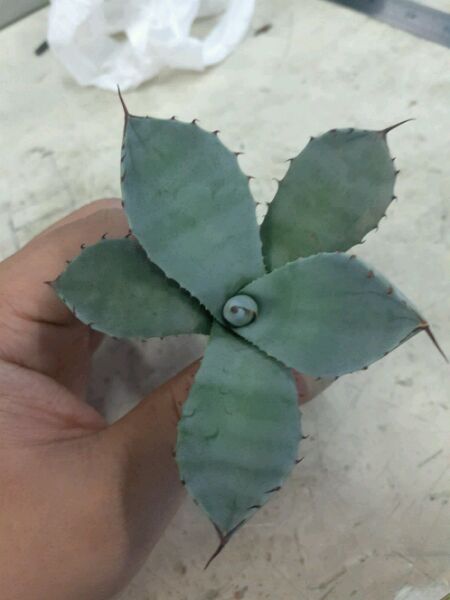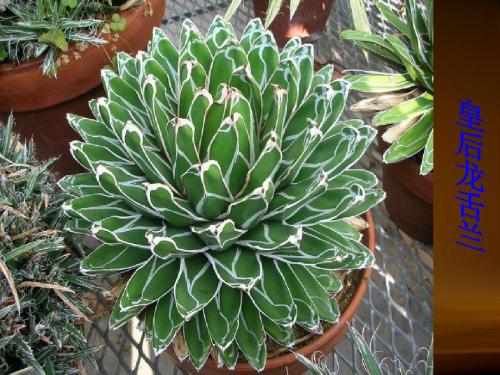Agave ovatifolia (Whales Tongue Agave) profile
Written by Maggie
Aug 14 2021

Whale's Tongue Agave, scientific name Agave ovatifolia, is a perennial evergreen flowering plant. Whale's Tongue Agave is distributed in America, with a warm climate. The stem is short, the leaves are much rigid, arranged in rosette, the margin serrate. When flowering, the inflorescence extends from the growing point, and the post-flowering rosette Withers and dies, but the succulent bud on the inflorescence and at the base of the rosette can be used as a continuation of the mother plant's life.

Agave ovatifolia morphological characteristics
Agave ovatifolia (Whale's Tongue Agave) stems lacking or having very short stems. Leaves are roselet-arranged, large and fleshy, fleshy or slightly woody, margin often or occasionally without thorns, apex often sharply spiked. Stems are stout, tall, branched; The flowers of agave ovatifolia are usually arranged in large, dense terminal spikes or panicles. Some species bloom once a year or every other year, others bloom and bear fruit only once, and then die. Perianth tube short, perianth lobes 6, narrow and similar; Agave ovatifolia has 6 stamens, attached to larynx or tube of perianth tube; Filaments are long and slender, often protruding from the perianth, anthers T-shaped; Ovary of Agave ovatifolia is inferior, 3-loculed, each locule with numerous ovules, style linear, stigma 3-lobed. Capsule long elliptic, ventricle dorsal 3 petals dehiscent;Seeds numerous, thin and flat, black.
Agave ovatifolia distribution range
Agave ovatifolia (Whale's Tongue Agave) is native to arid and semi-arid tropical regions of the Western Hemisphere, with the most species especially in Mexico.Agave ovatifolia is found in Guangdong, Fujian and Yunnan.
Agave ovatifolia growing environment
Whale 's Tongue Agave likes sunny, a bit cold, not resistant to shade, like a cool, dry environment, growth due to 15 to 25 ℃, grow best in night temperature is 10 to 16 ℃, under the temperature of 5 ℃ above can flourish, adult Whale' s Tongue Agave under the low temperature of 5 ℃ below zero blade suffered only a mild cold injury, 13 ℃ below zero aboveground cold decay, rhizome deathless, the following can embryonic development, normal growth, winter cold cold dry best for its birth, strong drought resistance force, the soil is relaxed,With loose, fertile and good drainage moist sandy soil is appropriate.
Agave ovatifolia propagation methods
Agave ovatifolia (Whale's Tongue Agave) division: more in the growing season, often can be combined with spring for pot. Remove the seedlings that germinate at the base of the old plant, and plant them in pots directly with or without roots.
Agave ovatifolia (Whale's Tongue Agave) cuttage: in the growth season, the leaf axillary germination buds removed, airing 5-7 days, such as dry wounds planted into the drainage, good air permeability of the culture soil, it is easy to root survive.
Agave ovatifolia (Whale's Tongue Agave) sowing: if the seeds can be collected can also sow reproduction. Sowing reproduction has a fairly high rate of seedling emergence and seedling management is not difficult. The optimal germination temperature of seeds is more than 15℃ at night and about 30℃ in the day. If the temperature is lower than 10℃ at night and 20℃ in the day, the germination rate of seeds will be greatly reduced and even can not sprout. After sowing, cover the surface of the basin with transparent glass for heat preservation and moisture. After sowing, seedlings of Agave ovatifolia can emerge in 7-10 days.
How to grow and care for Agave ovatifolia
Sunshine: The original environment where Whale's Tongue Agave (Whale's Tongue Agave) was grown was often quite hot in the sun, therefore,
Whale's Tongue Agave is very adaptable to the environment with abundant sunshine. If there is not enough sunshine in the environment, Agave ovatifolia will not grow well and lose its original charm. Therefore, in winter, the sunshine condition is relatively poor, so special attention should be paid to the sunshine condition of the cultivation environment of Whale's Tongue Agave, and sufficient sunshine should be provided as far as possible, so as to benefit the growth of Whale's Tongue Agave and make it past the winter safely.
Temperature: Whale's Tongue Agave has hard vitality, which of course also means that Whale's Tongue Agave can endure relatively harsh environments. In the south, even when the cold current comes in winter, as long as there is sufficient sunshine, Whale's Tongue Agave can also adapt. When we care for Whale's Tongue Agave, the lowest growth temperature of Whale's Tongue Agave is about 7℃, so when the temperature is too low, it is advisable to move it indoors for maintenance, and the rest of the time it can just be cultivated outdoors.
Watering: Whale's Tongue Agave has a strong nature and does not have a strict requirement on water. However, sufficient water must be provided during its growth period to make it grow well. In addition, excessive water should not be irrigated during the dormant period in winter, otherwise it is likely to cause root rot.
Fertilizing: Because Whale's Tongue Agave has a strong adaptability to the environment, it will not affect the development of the plant even if it grows on a rather poor soil.However, medium fertility can still make Whale's Tongue Agave grow better. The number of fertilization once a year is appropriate, do not often spray fertilizer, otherwise it is easy to cause fertilizer damage.
Basin-soil: The growth rate of Whale's Tongue Agave is very slow, so it is not necessary to change the basin frequently. Regular appreciation will not only not help the plant, but also worsen the growth potential of Whale's Tongue Agave. Whale's Tongue Agave is more suitable for dry environments. When we care for Whale's Tongue Agave, its basin soil should adopt sandy soil with good drainage ability.

Agave ovatifolia hydroponic method
1. Hydroponics can be carried out all year round in a heated environment. During hydroponics, all the roots of the Whale's Tongue Agave should be removed, disinfected with disinfectant, and soaked with rooting liquid for a certain period of time.
2. During Agave ovatifolia hydroponics, attention should be paid to the cabbage insect eating its leaves and hearts, so as to lose its commercial value and ornamental value. If the insect is found, it can be captured artificially or killed with insecticides.
3. Agave ovatifolia hydroponics should always get a good place in the sun and not be placed in a dark place for a long time. That way, the leaves are easy to become white and thin, so as to lose their ornamental value.
4. In winter, we should pay attention to heat preservation. During the day, we should place the glass bottles in plastic or cardboard boxes in the room without heating at night. If the leaves of Agave ovatifolia are yellow or drooping down without spirit, it may be frostbite, at this time, it needs some insulation measures. Then put it away from the door or window;
5. Be sure not to place Agave ovatifolia near the north. When changing the water in winter, you can change the water with warm water of 12 ℃ to 18 ℃.
Prevention and control of diseases and pests of Agave ovatifolia
Indoor cultivation of Whale's Tongue Agave often occurs leaf spot, anthracnose and gray mold, can be used 1% Bordeaux liquid or 50% carbendazim wettable powder 1000 times the liquid spray. Agave ovatifolia have scale insect harm, use 80% dichlorvos emulsion 1000 times liquid spray kill.Attention should be paid to ventilation and timely prevention.
Agave ovatifolia disease is mainly anthrax, the main damage to the leaf, the disease spot was light green or dark yellow brown, after gradually becoming black brown, finally the whole leaf rotted away. Etiology is muggy cultivation environment poor, poor ventilation, and pervious to light, too much nitrogen, etc., so we should improve the cultivation environment to prevent, when the summer heat note well ventilated, avoid heat and humidity environment, increase the applying of p, k content, in order to improve the plant disease resistance, and timely removal of rotting leaves, in order to avoid the spread of the pathogen, the early onset of spraying 70% midlothian 800 times liquid copper, green milk 100 times liquid, and anthrax f beauty, carbendazim, such as drugs, spray once every 7 to 10 days, the best cross use several kinds of drugs, so as to avoid resistance.
The insect pests of Whale's Tongue Agave are mainly scale insects, including shield scale, mealybug and root mealybug, etc. For the shield scale and mealybug parasitic on the surface of the Agave ovatifolia, the insect bodies can be removed with bamboo sticks and forceps, and then the plant can be sprayed with drugs. As for the root mealybug, once it is found, the pot should be turned over and the soil should be changed in time. During the soil changing, the insect bodies in the root should be cleaned, the seriously damaged root system of Agave ovatifolia should be cut off, the remaining root system should be soaked in the liquid medicine for 1-2 hours, and then put into the pot after being taken out and dried. Before the pot, the culture soil should be fumigated with high temperature or medicine to kill viruses to kill insects and sterilize. In addition, prevent the adverse effects of frostbite, sunburn, plant growth due to lack of light, and mechanical damage.
The main value of Agave ovatifolia
The botanical garden
The flower stem of the Whale's Tongue Agave is tall and the inflorescence is very beautiful at the end. The longest inflorescence recorded at the time of flowering is 3.9 meters, which is spectacular. Whale's Tongue Agave is of great ornamental value and is a common flower in urban gardens and green belts in southern China.
Eating
Whale's Tongue Agave has been used as a food resource in Central America for at least 9,000 years. People usually eat the soft, white, Starchy meristem at the base of Whale's Tongue Agive's stem or leaf. They can also bake or cook the skin of Whale's Tongue Agave.The leaves from Whale's Tongue Agave can also be used to feed livestock in northeastern Mexico.
Economic
The leaf fiber of Whale's Tongue Agave is used for making ship cables, ropes, sacks, etc., but the yield and quality of the fiber are not as good as sisal. The content of total steroid saponin is high, which is an important raw material for producing steroid hormone drugs.
Energy
The Whale's Tongue Agave plant can be grown as a biofuel in large areas of the tropics and subtropics that are too dry to grow crops. Due to the impact of synthetic fiber, the production of crude fiber of Whale's Tongue Agave is gradually declining. Planted 6,000 square meters of Whale's Tongue Agave plant can provide about 610 million liters of ethanol, which is a good supply for the increasingly tight global energy supply. In addition, almost one-fifth of the world's land surface is semi-arid, which provides a wider space for increasing biofuel production and expanding the planting area of Whale's Tongue Agave.

Latest Updated
- Benefits of Bugleweed - 7 Science-backed Health Benefits
- Bugleweed Dangers & Side Effects - Is It Poisonous?
- How to Plant Evergreen Trees - What You Should Know
- When to Plant Evergreens - Grow Guide for Evergreen Trees
- 12 Wonderful Evergreen Shrubs for Your Garden
- 12 Popular Evergreen Plants with Pictures for Beginners
- When And How To Prune A Lilac Bush Like a Pro
- How to Grow & Care for Lilac Vine (Hardenbergia Violacea)
- Japanese Lilac Tree (Syringa Reticulata) Care & Propagation Guide
- Shumard Oak Pros and Cons - What to Know
Popular Articles
- Winter maintenance of Antirrhinum Majus
- How to Grow Terminalia Mantaly Tree
- How to Grow and Care for Crossostephium Chinense
- How to grow Antirrhinum Majus in spring
- Peristeria Elata (Dove Orchid) Profile: Info & Care Guide
- Underwatered Snake Plant (Sansevieria Trifasciata) - Signs And How To Fix
- How to Care for Brazilian Jasmine Plant (Mandevilla Sanderi)
- How to Grow & Care for Graptopetalum Purple Delight in Summer
- Rosa Chinensis (China Rose): Plant Growing & Care Tips
- How to Care for Baby Sun Rose (Aptenia Cordifolia)